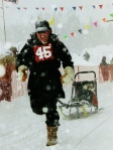By Robert Forto
Walker and Saunders
 Helene Whitehouse Walker was a respected breeder of Standard Poodles. Poodles were suffering from the stereotype that they were “sissies”, so in 1933 Walker decided to show dog fanciers that poodles were much more than just a pretty face.
Helene Whitehouse Walker was a respected breeder of Standard Poodles. Poodles were suffering from the stereotype that they were “sissies”, so in 1933 Walker decided to show dog fanciers that poodles were much more than just a pretty face.
Walker was by all accounts a persuasive woman. She began approaching dog clubs and breeders alike with the idea of something that had never been done before, holding competitive obedience trails at conformation dog shows. In 1933, at Mount Kisco, New York, eight dogs competed in America’s first obedience trial. North Westchester and Somerset Hills Kennel Clubs followed suit with obedience trials at their dog shows the following year. By 1936 the American Kennel Club (A.K.C.) developed the Regulations and Standards for Obedience Test Trials, and was using those regulations at licensed obedience events.
In 1937, Helene Walker and Blanche Saunders went on a cross country trip giving obedience demonstrations in order to sell the idea that training one’s dog was beneficial to the owner and the public. Four years later the New England Dog Training Club became the first obedience club to become a member of the A.K.C. Sixty-five years later there are over five hundred obedience clubs that are members of the A.K.C.
Blanche Saunders continued the campaign that she and Walker started on their incredible 1937 trek with amazing tenacity. She promoted the emerging sport of dog obedience at some of the nation’s largest venues and the most prestigious events. Saunders demonstrated dog obedience techniques in front of a crowd of seventy-thousand at Yankee Stadium. Her and her dogs also appeared at the premier event of National Dog Week, The Westminster Dog Show at Rockefeller Center.
The Complete Book of Dog Obedience by Saunders was published in 1954 and is purportedly the first book written “specifically for obedience instructors.” Treat Training and other positive reinforcement methods of training canines were virtually unknown in Saunders’ era. Training methods of the time revolved around the solicitation of escape and avoidance behaviors. In How Dogs Learn (1999), Burch and Bailey write:
“Saunders advocated praise, kindness, and fairness. She listed ‘too little praise’ as one of the most common mistakes of dog owners. Saunders was perhaps the first author to repeatedly stress the importance of reinforcement in training, thus starting the trend toward the positive training methods used today.”
Saunders did however specifically state that food should never be used to train canines, but that it was acceptable to use “a tidbit now and then to overcome a problem.” Saunders showed remarkable foresight in the understanding of what really motivates a dog.
_______________
Robert Forto is the host of The Dog Works Radio Show and is the training director of Alaska Dog Works. Robert Forto can be reached through his website at www.alaskadogworks.com







